模块6 Unit 1 Laughter is good for you Grammar and usage(1)课件(共33张PPT)
文档属性
| 名称 | 模块6 Unit 1 Laughter is good for you Grammar and usage(1)课件(共33张PPT) | 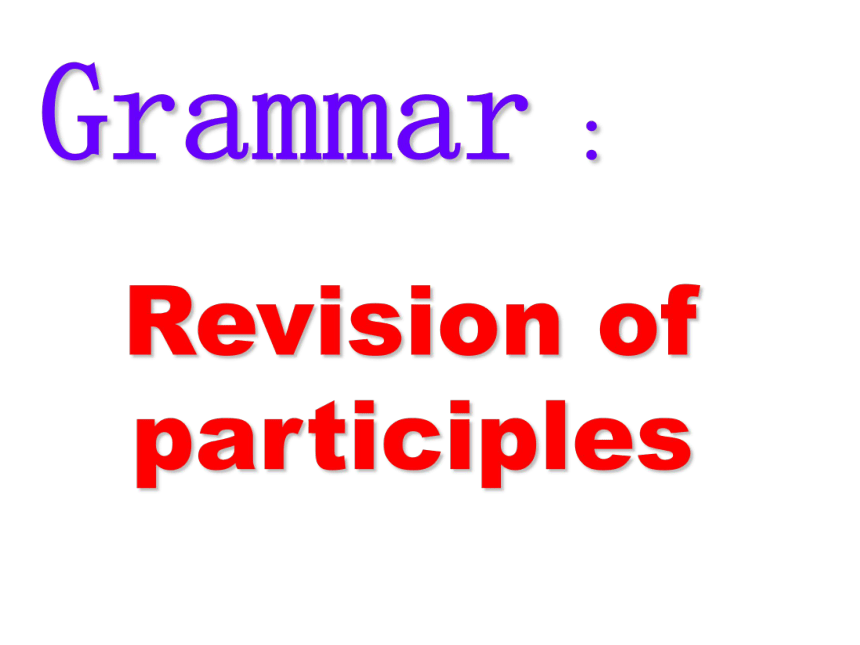 | |
| 格式 | zip | ||
| 文件大小 | 339.0KB | ||
| 资源类型 | 教案 | ||
| 版本资源 | 牛津译林版 | ||
| 科目 | 英语 | ||
| 更新时间 | 2019-07-28 22:08:06 | ||
图片预览



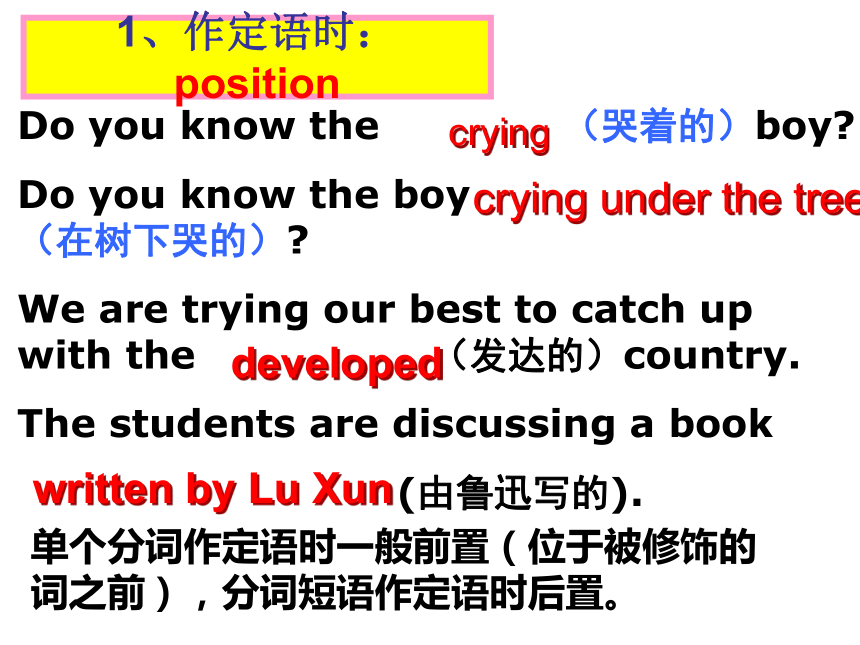

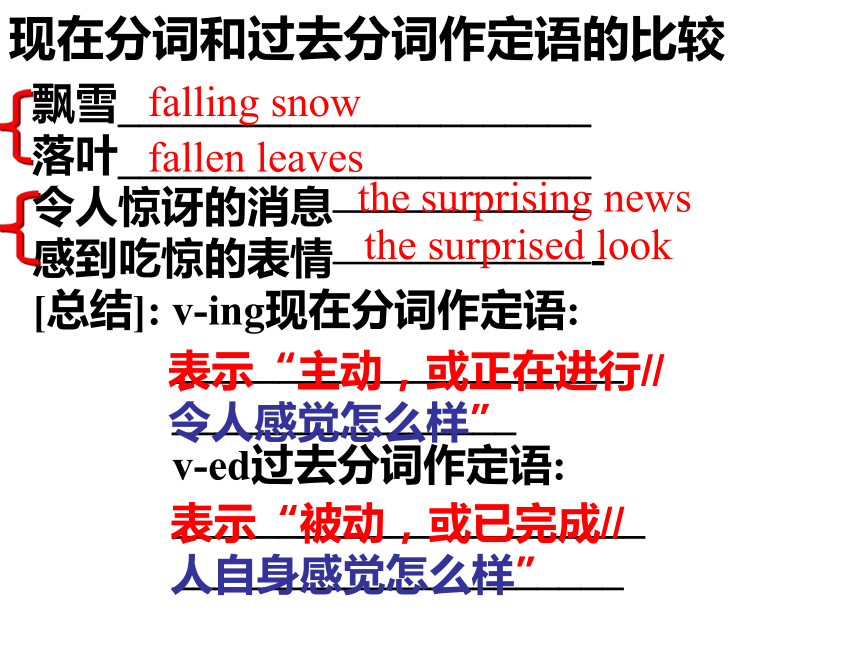
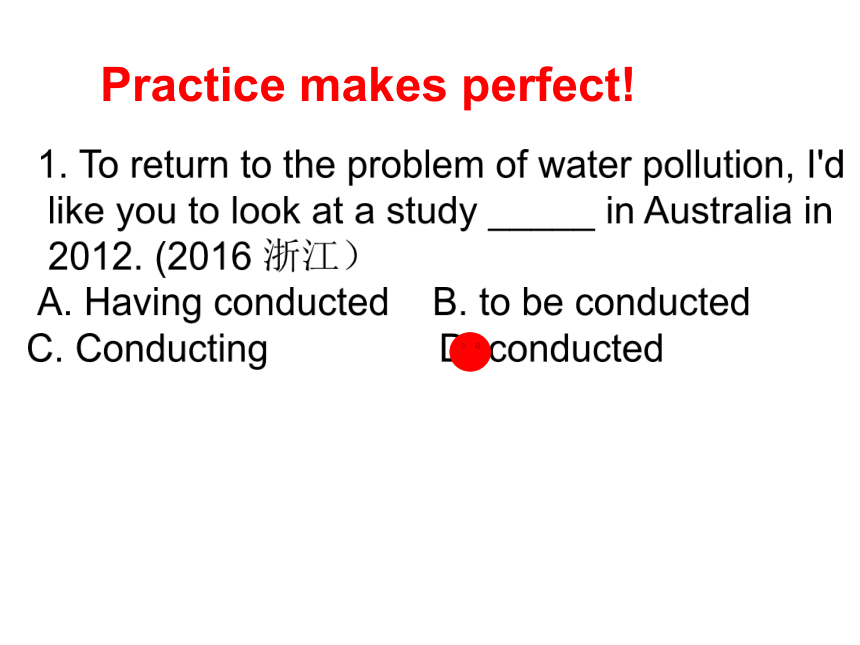
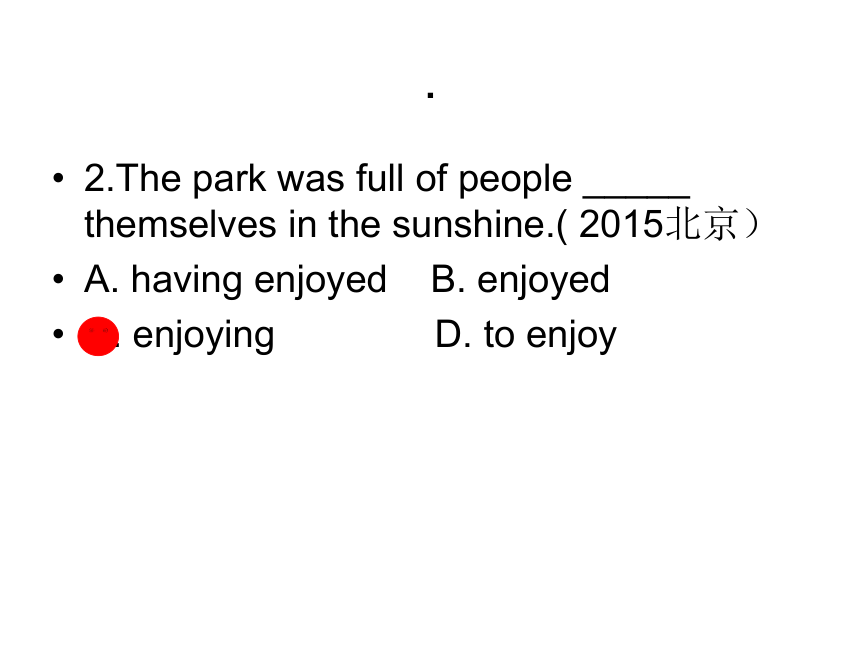
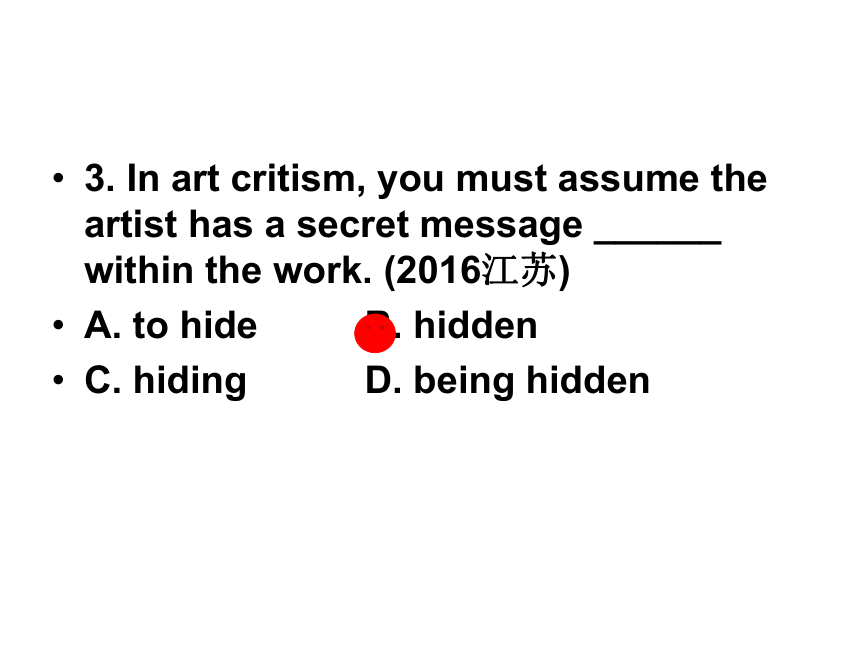

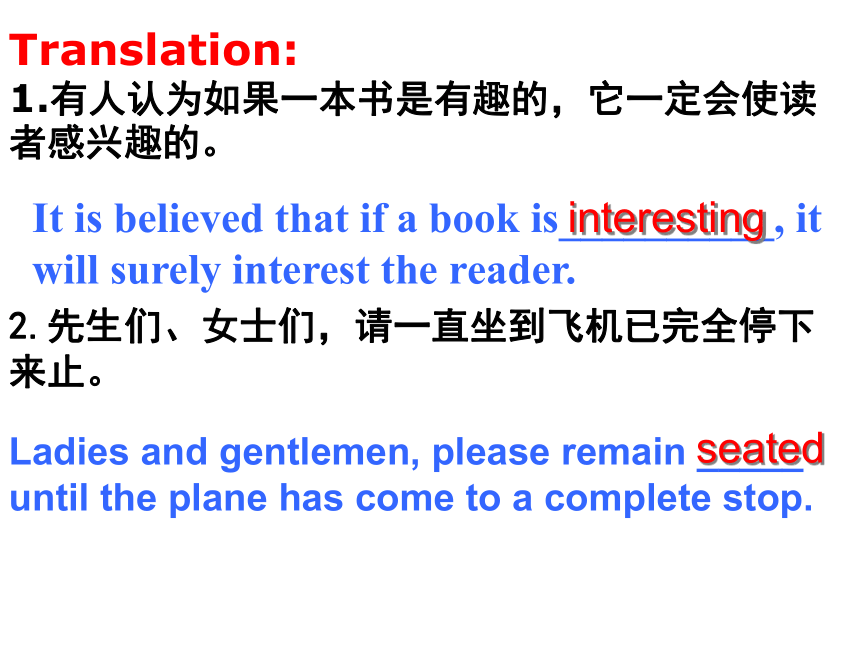
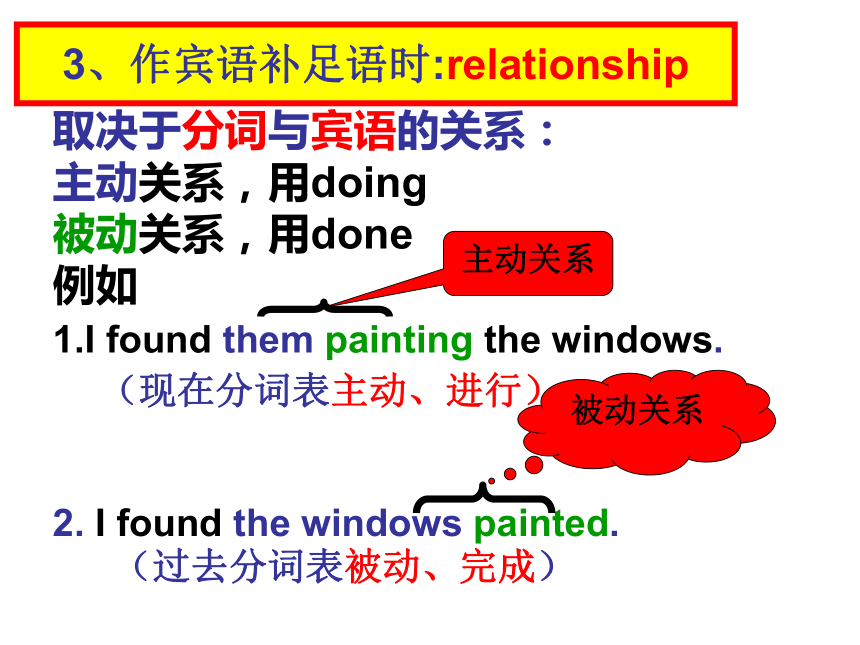
文档简介
课件33张PPT。Revision of participlesGrammar : 一、 分词的语法功能1.作定语
2.作表语
3.作宾语补足语
4.作状语二、现在分词与过去分词
的用法区别1、作定语时:positionDo you know the (哭着的)boy?
Do you know the boy (在树下哭的)?
We are trying our best to catch up with the (发达的)country.
The students are discussing a book
(由鲁迅写的).cryingcrying under the tree developedwritten by Lu Xun单个分词作定语时一般前置(位于被修饰的词之前),分词短语作定语时后置。作定语时:relationshipThe meeting held last week is very important.
2.Tell the children playing there not to make so
much noise.
被动关系主动关系现在分词和过去分词作定语的比较飘雪______________________
落叶______________________
令人惊讶的消息——————
感到吃惊的表情——————-
[总结]: v-ing现在分词作定语:
_____________________
________________
v-ed过去分词作定语:
______________________
_____________________ falling snowfallen leavesthe surprising news表示“主动,或正在进行//
令人感觉怎么样”表示“被动,或已完成//
人自身感觉怎么样”the surprised lookPractice makes perfect! 1. To return to the problem of water pollution, I'd like you to look at a study _____ in Australia in 2012. (2016 浙江)
A. Having conducted B. to be conducted
C. Conducting D. conducted
. 2.The park was full of people _____ themselves in the sunshine.( 2015北京)
A. having enjoyed B. enjoyed
C. enjoying D. to enjoy3. In art critism, you must assume the artist has a secret message ______ within the work. (2016江苏)
A. to hide B. hidden
C. hiding D. being hidden2、作表语时(跟在系动词后)现在分词多表示主语所具有的特征或属性;过去分词多表示主语所处的状态。现在分词表示“令人…的”,过去分词表示“感到…”.常见的分词有:amazed / amazing;
annoyed / annoying;
interested / interesting;
pleased / pleasing;
surprised / surprising;
satisfied / satisfying;
amused / amusingLearn them by heart!Translation:
1.有人认为如果一本书是有趣的,它一定会使读者感兴趣的。
2.先生们、女士们,请一直坐到飞机已完全停下来止。
It is believed that if a book is__________, it will surely interest the reader.Ladies and gentlemen, please remain _____ until the plane has come to a complete stop.interestingseated3、作宾语补足语时:relationship取决于分词与宾语的关系:
主动关系,用doing
被动关系,用done
例如
1.I found them painting the windows.
2. I found the windows painted. 主动关系被动关系(现在分词表主动、进行)(过去分词表被动、完成)Fill in the blanks1. (2011江苏)— You look upset. What’s the matter?
— I had my proposal __________(turn down) again.
2. (2014四川) The manager was satisfied to see many new products _________ after great effort. ( develop ) turned downdeveloped 4、作状语时:relationship
_____from the moon, the earth looks like a blue ball. (see)
_______nobody at home , he left. (see)
被动关系主动关系分词的选取:取决于分词与句子主语的关系:
主动关系:用 doing
被动关系:用 done
SeenSeeing1. ______ in a poor family, Nedia had only three years of schooling.( born )
(2016浙江)The cooling wind swept through our bedroom windows, ______ air conditioning unnecessary.
A. making B. to make
C. made D. being made
COME ON!BornNote 1:现在分词的一般式与完成式:一般式:doing 表示非谓语动作与谓语动作几乎同时发生。
完成式:having done 表示非谓语动作与谓语动作有着先后顺序 。 ____________ such heavy loss, the businessman didn’t have the courage to go on .(suffer)例如: ________the news, her fans
became wild with excitement. (hear)Hearing Having sufferedPractice makes perfect!
1.(13全国卷2) I got to the office earlier that day ,?_____the 7:30train from Paddington. A. caught?? B. to have caught??
C. to catch?? D. having caught2._____ nearly all our money, we couldn't afford to stay at a hotel.( 2014 江西)
A. Having spent B. To spent
C. Spent D. To have spentNote 2:分词作状语的基本原则:
分词作状语时,分词的逻辑主语必须与句子的主语保持一致。当非谓语动作的主语不是句子的主语时,必须加上其自己的逻辑主语,这种结构称为独立主格结构。如:Spring coming, the fields are full of life.再如:
Weather permitting ,we will go out for a spring outing.
The job done, we went home.
因为coming的逻辑主语,并不是the fields ,应补上它的逻辑主语spring, Consolidation:1.( 2015江苏) Much time _____ sitting at a desk , office workers are generally troubled by health problems.
A. being spent B. having spent
C. spent D. spending2. ( 2014 江苏) His lecture _______, a lively question-and-answer session followed.
A. being given B. having given
C. to be given D. having been given3. Everything ____ into consideration , they believed themselves more and returned to their position.
A. to taken B. taken
C. to be taken D. taking有些分词作状语时,其形式的选用不受上下文的影响,称作独立成分或插入语。常见的有:generally / frankly/ strictly speaking 一般而言/坦率地说/ 严格地说
judging from /by 根据…来判断
considering / taking …into consideration考虑到…;鉴于…
supposing / providing /provided that 如果
compared with/to 与…相比
例如
①______________his accent ,he is from the south .
②__________ your health, you ‘d better have a rest.
Note 3:独立成分作状语Judging from/byConsidering非谓语动词解题
四大步骤(一)分析句子结构,辨别“谓语与非谓语”(如果是非谓语,判断所充当的成分)______many times , but he still couldn't understand it .2. ______many times , he still couldn't understand it .A. Having been told B. Being told
C. He had been told D. Though he was toldC___A注意连词3.It ___ a hot day, we’d better go swimming.4. ____ a rainy day ; we decided not to go there.
is B. to be C. being
D.It being E. It was F. beenCE注意标点符号 非谓语动词虽不能作谓语,但仍具有动词特点,其逻辑上的动作执行者就叫做逻辑主语。(二)找逻辑主语1.Walking along the street one day, she saw
a little girl running up to her.
2.She finds the book interesting.
3.Most of the artists invited to the party were
from South Africa. 一般来说:
1.作状语的非谓语动词的逻辑主语是句子的主语;
2.作宾补的非谓语动词的逻辑主语是宾语;
3.作定语的非谓语动词的逻辑主语是被修饰词。
Everythingthey1._______ everything into consideration,
they ought to have another chance.2.Everything ______ into consideration,
they ought to have another chance. Fill in the blanks with the proper form of the verb “take”Taking taken(三)分析语态分析语态就是在确定逻辑主语之后,分析非谓语动词
和逻辑主语在搭配使用时是主动还是被动关系。“You can’t catch me !” Jane shouted, _______ away.
A. run B. running C.to run D. ran
2._____ in the early 20th century, the school keeps on inspiring children’s love of art.
A. To found B. Having founded
C. Founding D. FoundedJane (四)分析时态1. The building ____now will be a restaurant .2. The building ____ next year will be a restaurant .3. The building _____ last year is a restaurant.having been built B.to be built
C.being built D. built CBD 1.The teacher _____ us next term is Mr li.
2.The teacher _____ us this term is Mr li .
A teaching B to teach C taught D teachesAB非谓语动词解题步骤方法总结:
谓非谓,找主语,析语态,定时态。 Revise what we learned in this class and preview the next part. Homework:
2.作表语
3.作宾语补足语
4.作状语二、现在分词与过去分词
的用法区别1、作定语时:positionDo you know the (哭着的)boy?
Do you know the boy (在树下哭的)?
We are trying our best to catch up with the (发达的)country.
The students are discussing a book
(由鲁迅写的).cryingcrying under the tree developedwritten by Lu Xun单个分词作定语时一般前置(位于被修饰的词之前),分词短语作定语时后置。作定语时:relationshipThe meeting held last week is very important.
2.Tell the children playing there not to make so
much noise.
被动关系主动关系现在分词和过去分词作定语的比较飘雪______________________
落叶______________________
令人惊讶的消息——————
感到吃惊的表情——————-
[总结]: v-ing现在分词作定语:
_____________________
________________
v-ed过去分词作定语:
______________________
_____________________ falling snowfallen leavesthe surprising news表示“主动,或正在进行//
令人感觉怎么样”表示“被动,或已完成//
人自身感觉怎么样”the surprised lookPractice makes perfect! 1. To return to the problem of water pollution, I'd like you to look at a study _____ in Australia in 2012. (2016 浙江)
A. Having conducted B. to be conducted
C. Conducting D. conducted
. 2.The park was full of people _____ themselves in the sunshine.( 2015北京)
A. having enjoyed B. enjoyed
C. enjoying D. to enjoy3. In art critism, you must assume the artist has a secret message ______ within the work. (2016江苏)
A. to hide B. hidden
C. hiding D. being hidden2、作表语时(跟在系动词后)现在分词多表示主语所具有的特征或属性;过去分词多表示主语所处的状态。现在分词表示“令人…的”,过去分词表示“感到…”.常见的分词有:amazed / amazing;
annoyed / annoying;
interested / interesting;
pleased / pleasing;
surprised / surprising;
satisfied / satisfying;
amused / amusingLearn them by heart!Translation:
1.有人认为如果一本书是有趣的,它一定会使读者感兴趣的。
2.先生们、女士们,请一直坐到飞机已完全停下来止。
It is believed that if a book is__________, it will surely interest the reader.Ladies and gentlemen, please remain _____ until the plane has come to a complete stop.interestingseated3、作宾语补足语时:relationship取决于分词与宾语的关系:
主动关系,用doing
被动关系,用done
例如
1.I found them painting the windows.
2. I found the windows painted. 主动关系被动关系(现在分词表主动、进行)(过去分词表被动、完成)Fill in the blanks1. (2011江苏)— You look upset. What’s the matter?
— I had my proposal __________(turn down) again.
2. (2014四川) The manager was satisfied to see many new products _________ after great effort. ( develop ) turned downdeveloped 4、作状语时:relationship
_____from the moon, the earth looks like a blue ball. (see)
_______nobody at home , he left. (see)
被动关系主动关系分词的选取:取决于分词与句子主语的关系:
主动关系:用 doing
被动关系:用 done
SeenSeeing1. ______ in a poor family, Nedia had only three years of schooling.( born )
(2016浙江)The cooling wind swept through our bedroom windows, ______ air conditioning unnecessary.
A. making B. to make
C. made D. being made
COME ON!BornNote 1:现在分词的一般式与完成式:一般式:doing 表示非谓语动作与谓语动作几乎同时发生。
完成式:having done 表示非谓语动作与谓语动作有着先后顺序 。 ____________ such heavy loss, the businessman didn’t have the courage to go on .(suffer)例如: ________the news, her fans
became wild with excitement. (hear)Hearing Having sufferedPractice makes perfect!
1.(13全国卷2) I got to the office earlier that day ,?_____the 7:30train from Paddington. A. caught?? B. to have caught??
C. to catch?? D. having caught2._____ nearly all our money, we couldn't afford to stay at a hotel.( 2014 江西)
A. Having spent B. To spent
C. Spent D. To have spentNote 2:分词作状语的基本原则:
分词作状语时,分词的逻辑主语必须与句子的主语保持一致。当非谓语动作的主语不是句子的主语时,必须加上其自己的逻辑主语,这种结构称为独立主格结构。如:Spring coming, the fields are full of life.再如:
Weather permitting ,we will go out for a spring outing.
The job done, we went home.
因为coming的逻辑主语,并不是the fields ,应补上它的逻辑主语spring, Consolidation:1.( 2015江苏) Much time _____ sitting at a desk , office workers are generally troubled by health problems.
A. being spent B. having spent
C. spent D. spending2. ( 2014 江苏) His lecture _______, a lively question-and-answer session followed.
A. being given B. having given
C. to be given D. having been given3. Everything ____ into consideration , they believed themselves more and returned to their position.
A. to taken B. taken
C. to be taken D. taking有些分词作状语时,其形式的选用不受上下文的影响,称作独立成分或插入语。常见的有:generally / frankly/ strictly speaking 一般而言/坦率地说/ 严格地说
judging from /by 根据…来判断
considering / taking …into consideration考虑到…;鉴于…
supposing / providing /provided that 如果
compared with/to 与…相比
例如
①______________his accent ,he is from the south .
②__________ your health, you ‘d better have a rest.
Note 3:独立成分作状语Judging from/byConsidering非谓语动词解题
四大步骤(一)分析句子结构,辨别“谓语与非谓语”(如果是非谓语,判断所充当的成分)______many times , but he still couldn't understand it .2. ______many times , he still couldn't understand it .A. Having been told B. Being told
C. He had been told D. Though he was toldC___A注意连词3.It ___ a hot day, we’d better go swimming.4. ____ a rainy day ; we decided not to go there.
is B. to be C. being
D.It being E. It was F. beenCE注意标点符号 非谓语动词虽不能作谓语,但仍具有动词特点,其逻辑上的动作执行者就叫做逻辑主语。(二)找逻辑主语1.Walking along the street one day, she saw
a little girl running up to her.
2.She finds the book interesting.
3.Most of the artists invited to the party were
from South Africa. 一般来说:
1.作状语的非谓语动词的逻辑主语是句子的主语;
2.作宾补的非谓语动词的逻辑主语是宾语;
3.作定语的非谓语动词的逻辑主语是被修饰词。
Everythingthey1._______ everything into consideration,
they ought to have another chance.2.Everything ______ into consideration,
they ought to have another chance. Fill in the blanks with the proper form of the verb “take”Taking taken(三)分析语态分析语态就是在确定逻辑主语之后,分析非谓语动词
和逻辑主语在搭配使用时是主动还是被动关系。“You can’t catch me !” Jane shouted, _______ away.
A. run B. running C.to run D. ran
2._____ in the early 20th century, the school keeps on inspiring children’s love of art.
A. To found B. Having founded
C. Founding D. FoundedJane (四)分析时态1. The building ____now will be a restaurant .2. The building ____ next year will be a restaurant .3. The building _____ last year is a restaurant.having been built B.to be built
C.being built D. built CBD 1.The teacher _____ us next term is Mr li.
2.The teacher _____ us this term is Mr li .
A teaching B to teach C taught D teachesAB非谓语动词解题步骤方法总结:
谓非谓,找主语,析语态,定时态。 Revise what we learned in this class and preview the next part. Homework:
